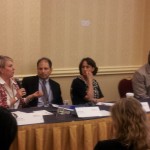Leadership for Healthy Communities hosts 2013 Childhood Obesity Prevention Summit
September 29, 2013 | Community News, Community News and Media
 On September 29 nearly 300 state and local policy-makers and childhood obesity prevention advocates from across the country gathered in Baltimore, Maryland for the 2013 Childhood Obesity Prevention Summit – “The Future of Childhood Obesity: State and Local Success to National Progress.” The summit focused on childhood obesity prevention efforts at the local and state level and how those efforts are influencing national initiatives to promote healthy eating and active living.
On September 29 nearly 300 state and local policy-makers and childhood obesity prevention advocates from across the country gathered in Baltimore, Maryland for the 2013 Childhood Obesity Prevention Summit – “The Future of Childhood Obesity: State and Local Success to National Progress.” The summit focused on childhood obesity prevention efforts at the local and state level and how those efforts are influencing national initiatives to promote healthy eating and active living.
“It was a powerful gathering of policy-makers and advocates focused on creating and enhancing efforts to get communities more physically active and focused on healthier eating,” said Darrin Anderson, Sr., Ph.D., deputy director, New Jersey Partnership for Healthy Kids. “There was a lot of discussion on resources and opportunities for low-income and rural communities to have access to healthier choices.”
U.S. Representative Elijah Cummings, J.D., served as keynote speaker to officially launch the Summit. “Representative Cummings is a huge advocate for health and social equity,” said Anderson. “He urged us to create solidarity as we work to curb childhood obesity.”
Anderson also served as session chair for a panel discussion titled, “When Snacks Attack: Reducing Junk Food Marketing to Children.” Panelists from Berkeley Media Studies Group, Center for Digital Democracy and Yale University spoke on how the food and beverage industry is using new marketing methods, including digital advertising to promote unhealthy products to children and adolescents, and the role that policy-makers can have in helping to limit junk food marketing in their schools, cities and states.
Anderson noted that the panel discussion he chaired left people with three key takeaways. First, that everyone, especially parents, needs to be aware of the marketing tactics infiltrating our daily lives that promote unhealthy products. Second that policymakers and advocates must work with the food and beverage industry so they can become “health partners,” not adversaries. “The third take away is that with new social media tools and GPS, advertisers are well aware of the products we purchase and view on line, as well as the stores we visit,” said Anderson. “Armed with this information, advertisers are sending targeted marketing to us and our children, who often have their own cell phones and are active on social media. As part of our “healthy partnership” goal, we need to seek ways for advertisers to send healthy food and lifestyle messages via these tools.”
More than 10 breakout sessions were held during the three-day conference, including such topics as “Fit Kids: Policies to Encourage Nutrition and Physical Activity In and Out of School”, “Race and Place Matter: Designing Policies to End Health Disparities” and “Childhood Obesity and America’s Fiscal Future: Assessing the Impact of the Healthy Communities Movement”.
“We’ve started, quite successfully, in New Jersey a dialogue that allows us to work with communities, parents, vendors, agencies and others in an environment that is about joint progress minus the blame,” said Anderson. “I was excited to see that same spirit throughout the many sessions and conversations at this year’s Childhood Obesity Summit.”
SHARE:
Contact Us: 609-278-9622
Follow Us On: